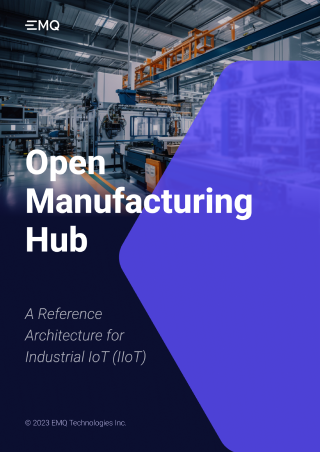Incorporating the Unified Namespace with ISA-95: Best Practices

Table of Contents
- Replacing ISA-95 Layer Models with Unified Namespace Architecture
- Integrating ISA-95 Naming Convention Model into Unified Namespace
- Utilizing the EMQX ACL Mechanisms for Unified Namespace Security
- Supporting the Data Consistency with Gobal Standard Industrial Protocols
- Synchronizing Multi-Site Across Disparate Manufacturing Processes
- Scaling the Unified Namespace as an Organization Grows
- Compliance and Governance with ISA-95 Standard
- Conclusion
ISA-95, also known as the "Enterprise-Control System Integration" standard, provides a framework for integrating enterprise and control systems in manufacturing and production environments. Incorporating a Unified Namespace with the ISA-95 standard involves adhering to best practices that are consistent with the principles and guidelines of ISA-95.
This blog will guide you on incorporating a Unified Namespace with ISA-95 with some best practices. We will use EMQX as an MQTT broker and Neuron as an Industrial Connectivity Gateway.
Replacing ISA-95 Layer Models with Unified Namespace Architecture
The traditional ISA-95 standard uses layer models to categorize different levels of operation, from the enterprise to the control system. However, the Unified Namespace concept proposes to move away from these discrete layers and instead advocates a cohesive and interconnected framework where all components and data are organized under a single, unified naming convention, facilitated by Neuron's data acquisition capabilities and EMQX's dynamic topic-based structure.
This approach seeks to break down silos and enhance interoperability by treating all components, whether IT or OT, as part of a unified system. Neuron's ability to bridge different industrial protocols and standards ensures that diverse devices and sensors can communicate seamlessly through EMQX's MQTT-based approach. Replacing ISA-95 Layer Models with a Unified Namespace through the integration of EMQX and Neuron offers a modernized way of managing industrial operations.

Integrating ISA-95 Naming Convention Model into Unified Namespace
By applying the ISA-95 naming convention, equipment, processes, and resources are labeled consistently, improving clarity and communication across the unified namespace. The equipment model hierarchy, which typically includes levels such as enterprise, site, area, unit, and control module, provides a logical structure for organizing these components within the unified namespace, which is structured in the EMQX broker as a central data repository.
This integration seeks to leverage the strengths of both approaches: the ISA-95 framework provides a systematic way to structure equipment and processes, while the unified namespace promotes flexibility, data sharing, and cross-functional collaboration. Successful implementation of this approach requires careful consideration of naming conventions, ensuring compatibility with existing systems, and resolving potential conflicts between standardized hierarchy and the desire for seamless connectivity.
Utilizing the EMQX ACL Mechanisms for Unified Namespace Security
EMQX's Access Control Lists (ACLs) for topic access within the Unified Namespace provide a robust security mechanism tailored for industrial environments. By allowing administrators to fine-tune data access on a per-topic basis, ACLs enhance security, confidentiality, and data integrity. This alignment with the principles of Role-Based Access Control streamlines permissions management, granting authorized individuals or groups precise levels of access while preventing unauthorized data exposure or manipulation.
In addition, the integration of EMQX's ACLs seamlessly supports the Unified Namespace concept by ensuring that only relevant individuals have access to specific MQTT topics. This controlled access enhances privacy, facilitates regulatory compliance, and enables detailed audit trails. As industrial operations scale, ACLs maintain efficiency by adapting to changing roles and responsibilities, contributing to a secure and organized environment that meets the needs of modern industry.
Supporting the Data Consistency with Global Standard Industrial Protocols
Neuron's support for some mainstream standard industrial protocols such as "MQTT Sparkplug" and "OPC UA over MQTT" plays a pivotal role in ensuring data consistency within the Unified Namespace framework. These protocols facilitate seamless communication and data exchange between industrial devices, Neuron Industrial Connectivity Gateway, and the EMQX MQTT broker. The integration of these protocols enhances the accuracy, reliability, and efficiency of data sharing across the entire industrial ecosystem.
Major technology giants like AWS, Azure, Siemens, Beckhoff, and others strongly endorse these technologies for industrial IoT and automation. MQTT Sparkplug streamlines data communication for real-time exchanges in industrial and IoT settings, with major tech players offering robust support through MQTT broker services. Meanwhile, the fusion of OPC UA and MQTT, OPC UA over MQTT, ensures secure and efficient data transfer in industrial applications backed by implementations from these leaders. This backing highlights the pivotal role of these protocols in modernizing industrial processes, fostering data-driven decisions, and driving innovation.
Synchronizing Multi-Site Across Disparate Manufacturing Processes
Leveraging EMQX's high-speed data replication capabilities to establish multi-site synchronization and create a Unified Namespace offers a multitude of benefits. First, the real-time data consistency achieved through rapid replication ensures that updates made at one site are promptly mirrored across the enterprise. This immediate synchronization minimizes latency and provides a unified, up-to-date dataset accessible enterprise-wide, enabling informed decision-making regardless of geographical location.
Moreover, the agility and efficiency gained from reduced latency contribute to improved collaboration and streamlined operations. Teams spread across various sites can access synchronized data, fostering better communication and cooperation. Additionally, the capacity for high-speed replication bolsters disaster recovery and redundancy strategies. In the face of unexpected disruptions, replicated data ensures swift recovery and minimal downtime, supporting uninterrupted business operations.
Furthermore, the scalability of high-speed replication aligns perfectly with the enterprise's growth trajectory. As the organization expands or integrates new sites, the replication mechanism adapts seamlessly to accommodate these changes. Industries with regulatory compliance requirements also benefit, as high-speed replication maintains uniform and compliant data across all sites. Ultimately, EMQX's high-speed replication empowers enterprises to react agilely to market dynamics, enhance customer experiences, and stay competitive through real-time insights and collaborative advantages across the Unified Namespace.
Scaling the Unified Namespace as an Organization Grows
Designing a Unified Namespace architecture to accommodate scalability as an organization grows involves creating a flexible and adaptable structure that can seamlessly incorporate new assets, processes, and sites in the future. EMQX and Neuron can play pivotal roles in ensuring this scalability of the Unified Namespace architecture.
Moreover, EMQX's support for role-based access control mechanisms aligns with ISA-95 security recommendations. This means that as the organization scales, data access can be finely controlled based on user roles and responsibilities, enhancing data governance and security. Neuron, on the other hand, aids in connecting diverse industrial devices, sensors, and machinery across the expanding network. Its support for protocols like "MQTT Sparkplug" and "OPC UA over MQTT" ensures that data flows smoothly within the Unified Namespace, even as the organization grows.
Compliance and Governance with ISA-95 Standard
Incorporating compliance and governance into the Unified Namespace approach is crucial. This involves aligning data organization and integration practices with standards like ISA-95 and other industry benchmarks, while also implementing robust data governance measures. Data governance ensures that data quality, consistency, and security are upheld within the Unified Namespace, promoting accurate decision-making and seamless interoperability across the industrial ecosystem.
Conclusion
By following these best practices with EMQX and Neuron, organizations can effectively organize a Unified Namespace in alignment with the ISA-95 standard. This approach enhances data integration, collaboration, and decision-making, ultimately leading to improved operational efficiency in manufacturing and production environments.
